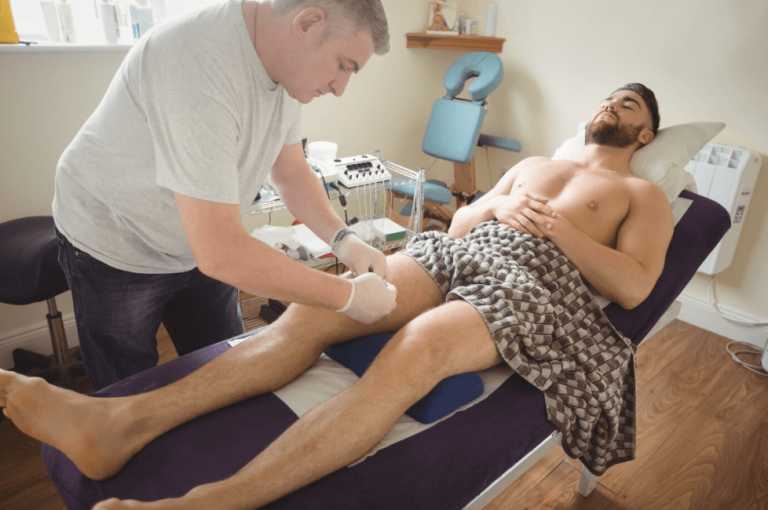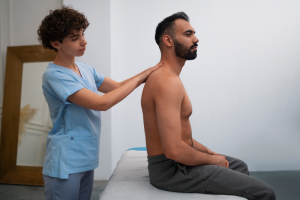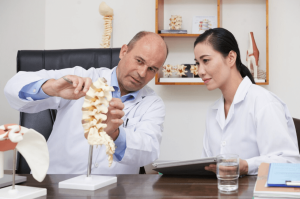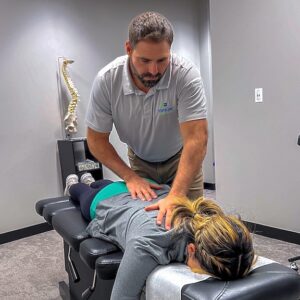In the world of injury rehabilitation, various treatment modalities aim to expedite healing and restore function. One such innovative method gaining traction is cold laser therapy. Whether you’re an athlete recovering from a sports injury or someone seeking relief from chronic pain, understanding the effectiveness of cold laser therapy could be pivotal in your recovery journey.
What is Cold Laser Therapy?
Cold laser therapy, also known as low-level laser therapy (LLLT) or photobiomodulation, involves the use of low-intensity lasers or light-emitting diodes (LEDs) to stimulate tissue healing and reduce inflammation. Unlike surgical lasers, cold lasers do not produce heat and are non-invasive. This therapy works on the principle of photobiomodulation, where specific wavelengths of light penetrate the skin and interact with cells to promote healing.
How Does Cold Laser Therapy Work?
When targeted at injured areas, the photons emitted by the cold laser devices penetrate deep into the tissue. These photons are absorbed by cells within the body, triggering a cascade of biochemical reactions. One key effect is the stimulation of mitochondria, the powerhouse of the cell, enhancing their activity and leading to increased production of adenosine triphosphate (ATP), which fuels cellular processes. This heightened cellular activity promotes tissue repair, reduces inflammation, and alleviates pain.
Effectiveness of Cold Laser Therapy in Injury Rehabilitation
Enhanced Cellular Repair: Cold laser therapy operates at a cellular level, stimulating the mitochondria within cells. This stimulation leads to an increase in ATP production, the energy currency of cells. With more ATP available, cells can perform their functions more efficiently, accelerating the repair and regeneration of injured tissues. This mechanism promotes the synthesis of proteins and initiates the healing process at a fundamental level.
Reduced Inflammation: By targeting inflammatory markers such as prostaglandins and cytokines, cold laser therapy helps regulate the body’s inflammatory response. This modulation leads to a reduction in the production of these inflammatory substances, thereby decreasing swelling, pain, and tenderness in the injured area. Through this anti-inflammatory effect, the therapy promotes a more conducive environment for healing.
Improved Blood Circulation: The application of cold laser therapy triggers vasodilation, the widening of blood vessels, which in turn enhances blood circulation in the affected region. Improved blood flow carries oxygen, nutrients, and immune cells to the injured site, facilitating the removal of metabolic waste and aiding in the delivery of essential components necessary for tissue repair. Enhanced circulation promotes faster healing by supporting the body’s natural regenerative processes.
Pain Management: Cold laser therapy’s ability to stimulate the release of endorphins, the body’s natural painkillers, plays a pivotal role in pain management. These endorphins act on the nervous system to reduce the perception of pain. The therapy effectively alleviates both acute and chronic pain, offering individuals a non-pharmacological approach to pain relief without the potential side effects associated with medication.
Muscle Recovery and Regeneration: In cases of muscle injury or strain, cold laser therapy aids in muscle recovery by reducing inflammation and oxidative stress. It helps in minimizing muscle spasms and enhancing muscle regeneration, allowing the injured muscles to heal more efficiently. This promotes not only quicker recovery but also restores muscle strength and flexibility.
Promotion of Collagen Production: Collagen, a structural protein, is vital for tissue repair and regeneration. Cold laser therapy stimulates fibroblasts, the cells responsible for producing collagen. By enhancing collagen synthesis, the therapy accelerates the formation of new connective tissue, contributing significantly to the healing process and improving tissue strength and elasticity.
Acceleration of Wound Healing: Cold laser therapy expedites wound healing by fostering a favorable environment for tissue regeneration. The increased cellular activity and improved blood circulation at the wound site aid in the removal of damaged tissue and the promotion of granulation tissue formation. This leads to faster closure of wounds, reducing the risk of infection and complications associated with slow-healing wounds.
Non-invasive Nature and Minimal Side Effects: As a non-invasive treatment modality, cold laser therapy is gentle and typically painless. It does not involve incisions, injections, or medications, which significantly reduces the risk of adverse reactions or complications. The therapy’s non-invasive nature makes it suitable for a wide range of individuals seeking rehabilitation without the worry of significant side effects.
Versatility in Treatable Conditions: Cold laser therapy showcases its efficacy across a spectrum of injuries and conditions. From acute injuries like sprains, strains, and contusions to chronic conditions such as arthritis, tendonitis, and bursitis, the therapy demonstrates its adaptability. It’s also effective in addressing soft tissue injuries, nerve pain, and musculoskeletal disorders, providing relief and promoting recovery in diverse scenarios.
Complementary Therapy in Rehabilitation: Integrating cold laser therapy into a comprehensive rehabilitation plan enhances its effectiveness. When combined with other modalities such as physical therapy, chiropractic care, or exercises tailored to the individual’s needs, the therapy amplifies the overall outcomes. Its synergistic effect with other rehabilitation techniques accelerates recovery, improves mobility, and reduces the risk of recurrent injuries, offering a holistic approach to rehabilitation.
Conditions Benefiting from Cold Laser Therapy
Cold laser therapy has shown promising results in treating various conditions, including but not limited to:
Arthritic Joint Pain Relief: Cold laser therapy showcases its effectiveness in mitigating the symptoms of arthritis, including osteoarthritis and rheumatoid arthritis. By penetrating deep into the affected joints, the therapy reduces inflammation, alleviates pain, and enhances joint mobility. It promotes cartilage repair and stimulates synovial fluid production, crucial for joint lubrication, thereby improving the overall function and reducing the stiffness associated with arthritic conditions.
Sports-Related Injuries: Athletes frequently encounter injuries such as sprains, strains, and ligament tears due to strenuous physical activities. Cold laser therapy expedites the healing process by accelerating tissue repair and modulating inflammation. Its ability to promote collagen synthesis aids in restoring damaged tissues, facilitating faster recovery, and allowing athletes to return to their sport with reduced downtime.
Tendonitis and Tendinosis: Tendon-related issues like Achilles tendonitis, tennis elbow, and rotator cuff tendonitis benefit from cold laser therapy. The therapy targets inflamed tendons, stimulating cellular repair mechanisms, and enhancing blood flow to the affected area. By promoting tissue regeneration and reducing scar tissue formation, it assists in restoring tendon strength and flexibility, aiding in the resolution of chronic tendon-related conditions.
Back and Neck Pain: Chronic back and neck pain stemming from various causes, including injury or degenerative conditions, can be debilitating. Cold laser therapy’s ability to penetrate deep tissues helps in reducing inflammation, relaxing muscles, and promoting cellular regeneration in these areas. By alleviating pain and improving tissue healing, it enhances spinal mobility and function, offering relief to individuals dealing with persistent back or neck discomfort.
Carpal Tunnel Syndrome: Individuals experiencing wrist pain and numbness due to carpal tunnel syndrome find relief through Lake Zurich cold laser therapy. By reducing inflammation and swelling around the median nerve, the therapy alleviates pressure, diminishing pain and tingling sensations. It also supports the healing of damaged tissues, restoring proper hand function and relieving discomfort associated with this nerve compression condition.
Plantar Fasciitis: Foot pain arising from inflammation of the plantar fascia can impede daily activities. Cold laser therapy targets the affected area, reducing inflammation and promoting tissue repair in the plantar fascia. By stimulating cellular activity, it aids in the regeneration of healthy tissue, alleviating heel pain, and improving mobility, enabling individuals to resume regular walking activities comfortably.
Wound Healing: Chronic wounds or ulcers that struggle to heal benefit significantly from cold laser therapy. The therapy’s ability to accelerate cellular metabolism and promote blood circulation at the wound site expedites tissue regeneration. By reducing bacterial load, promoting granulation tissue formation, and facilitating collagen synthesis, it aids in closing wounds faster and minimizing the risk of infections, thereby fostering optimal wound healing.
Fibromyalgia Management: Cold laser therapy serves as a complementary approach in managing fibromyalgia symptoms. By targeting trigger points and tender areas, the therapy helps in reducing pain intensity and improving muscle flexibility. It aids in releasing muscle tension, promoting relaxation, and enhancing sleep quality, contributing to improved overall well-being in individuals coping with fibromyalgia.
Temporomandibular Joint (TMJ) Disorders: TMJ disorders causing jaw pain, clicking, or restricted movement find relief through cold laser therapy. The therapy targets the inflamed temporomandibular joint, reducing inflammation, and relaxing the surrounding muscles. By promoting tissue repair and alleviating pain, it improves jaw mobility and function, allowing for better oral health and reduced discomfort.
Post-Surgical Recovery: Incorporating cold laser therapy into post-operative care aids in the healing process after various surgeries. The therapy accelerates tissue repair, reduces scar tissue formation, and minimizes postsurgical pain and swelling. It enhances circulation, promoting oxygen and nutrient delivery to the surgical site, facilitating quicker recovery and improving overall rehabilitation outcomes.
The Evolve Chiropractic Approach
Holistic Wellness Focus: Evolve Chiropractic’s approach to wellness extends beyond the treatment of symptoms; it emphasizes holistic well-being. By recognizing that health encompasses physical, mental, and emotional aspects, the practice offers a comprehensive approach that integrates various therapies and practices. This comprehensive outlook ensures that patients receive care that not only addresses their immediate concerns but also supports their overall health and vitality.
Patient-Centered Care: At Evolve Chiropractic, patient-centered care isn’t just a phrase; it’s a cornerstone of their practice. This approach places significant emphasis on actively involving patients in their healthcare journey. Practitioners take the time to listen attentively to patients’ concerns, preferences, and goals. Through open communication and shared decision-making, patients are empowered to play an active role in their treatment plans, fostering a sense of ownership and collaboration in the healing process.
Evidence-Based Practices: The foundation of Evolve Chiropractic’s approach lies in evidence-based practices. Chiropractors stay updated on the latest scientific research and developments in chiropractic care and related fields. By integrating clinically proven techniques and treatments, they ensure that patients receive care based on validated methods, promoting effectiveness and safety in their treatment protocols.
Customized Treatment Plans: Evolve Chiropractic doesn’t believe in one-size-fits-all approaches. Each patient undergoes a comprehensive evaluation to understand their unique health needs and concerns fully. This detailed assessment serves as the basis for designing individualized treatment plans. These plans are tailor-made, incorporating a variety of modalities such as chiropractic adjustments, cold laser therapy, exercises, nutritional guidance, and lifestyle modifications, all personalized to address the specific condition and goals of the patient.
Multidisciplinary Collaboration: The practice fosters collaboration among a spectrum of healthcare professionals. Chiropractors at Evolve Chiropractic work hand-in-hand with other healthcare providers, including physical therapists, massage therapists, nutritionists, and primary care physicians. This collaborative approach ensures that patients receive holistic care that addresses various aspects of their health, integrating multiple perspectives to optimize treatment outcomes.
Emphasis on Education and Empowerment: Educating patients is a vital aspect of Evolve Chiropractic’s approach. Chiropractors take the time to explain patients’ conditions, treatment options, and preventive measures in understandable terms. By empowering patients with knowledge about their health, conditions, and treatment plans, they encourage active participation and informed decision-making in managing their well-being.
Focus on Functional Improvement: Beyond symptom relief, Evolve Chiropractic focuses on enhancing functional capacity and mobility. Chiropractors prioritize restoring and improving the body’s functionality, aiming for long-term health benefits. This involves not just addressing immediate discomfort but also employing rehabilitative exercises, ergonomic adjustments, and lifestyle modifications to support sustained functional improvement and overall wellness.
Commitment to Ongoing Support: The practice is committed to providing continuous support throughout a patient’s wellness journey. Beyond the initial treatment phase, chiropractors offer ongoing monitoring, periodic evaluations, and adjustments to treatment plans as needed. This commitment ensures that patients receive consistent care, allowing for adaptations as their health progresses and ensuring sustained progress towards their health goals.
In a world where options for injury rehabilitation abound, understanding the potential benefits of cold laser therapy in Lake Zurich empowers individuals to make informed choices on their path to recovery.
275 S Rand Rd ste a9, Lake Zurich, IL 60047
(224) 662-4732
https://myevolvechiropractor.com/locations/chiropractor-lake-zurich-il





